Posted by Umm Sahl in Scientific Miracles | 3 Comments
The Birth of a Human Being
Based on the works of Harun Yahya
Many diverse subjects are mentioned in the Qur’an in the course of inviting people to believe. Sometimes the heavens, sometimes animals, and sometimes plants are shown as evidence to man by God. In many of the verses, people are called upon to turn their attention to their own creation. They are often reminded how man came into the world, which stages he has passed through, and what his essence is:
“It is We Who have created you. Why, then, do you not accept the truth? Have you ever considered that (seed) which you emit? Is it you who create it? Or are We the Creator?” (The Qur’an, 56:57-59)
The creation of man, and the miraculous aspect of this, is stressed in many other verses. Some items of information within these verses are so detailed that it is impossible for anyone living in the 7th century to have known them. Some of these are as follows:
1. Man is not created from the entire semen, but only a very small portion of it (sperm).
2. It is the male that determines the sex of the baby.
3. The human embryo adheres to the mother’s uterus like a leech.
4. The embryo develops in three dark regions in the uterus.
People living when the Qur’an was revealed, to be sure, knew that the basic substance of birth was related to the semen of the male emitted during sexual intercourse. And the fact that the baby was born after a nine-month period was obviously an observable event not calling for any further investigation. However, the items of information just quoted were far above the level of learning of the people living at that time. These were verified by 20th century science.
Now, let us go over them one by one.
A Drop of Semen
During sexual intercourse, 250 million sperms are emitted from the male at a time. The sperms undertake an arduous journey in the mother’s body until they make it to the ovum. Only a thousand out of 250 million sperms succeed in reaching the ovum. At the end of this five-minute race, the ovum, half the size of a grain of salt, will let only one of the sperms in. That is, the essence of man is not the whole semen, but only a small part of it. This is explained in the Qur’an:
“Does man reckon he will be left uncontrolled (without purpose)? Was he not once a drop of ejected semen?” (The Qur’an, 75:36-37)
As we have seen, the Qur’an informs us that man is made not from the entire semen, but only a small part of it. That the particular emphasis in this statement announces a fact only discovered by modern science is evidence that the statement is divine in origin.
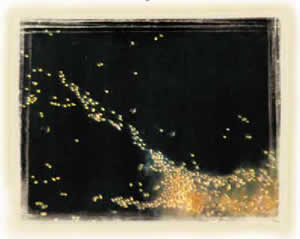 In the picture to the left, we see semen ejected into the uterus. Only very few sperms out of 250 million sperms emitted from the male can make it to the ovum. The sperm that will fertilise the egg is the only one out of a thousand sperms that have managed to survive. The fact that man is made not from the entire semen, but only a small part of it, is related in the Qur’an with the expression, “a drop of ejected semen”.
In the picture to the left, we see semen ejected into the uterus. Only very few sperms out of 250 million sperms emitted from the male can make it to the ovum. The sperm that will fertilise the egg is the only one out of a thousand sperms that have managed to survive. The fact that man is made not from the entire semen, but only a small part of it, is related in the Qur’an with the expression, “a drop of ejected semen”.
The Mixture in the Semen
The fluid called semen, which contains the sperms, does not consist of sperms alone. On the contrary, it is made up of a mixture of different fluids. These fluids have different functions, such as containing the sugar necessary for providing energy for the sperms, neutralising the acids at the entrance of the uterus, and creating a slippery environment for the easy movement of the sperms.
Interestingly enough, when semen is mentioned in the Qur’an, this fact, which was discovered by modern science, is also referred to, and semen is defined as a mixed fluid:
“We created man from a mingled drop to test him, and We made him hearing and seeing.” (The Qur’an, 76:2)
In another verse, semen is again referred to as a mixture, and it is stressed that man is created from the “extract” of this mixture:
“He who has created all things in the best possible way. He commenced the creation of man from clay; then He made his progeny from an extract of discarded fluid.” (The Qur’an, 32:7-8)
The Arabic word “sulala”, translated as “extract”, means the essential or best part of something. By either implication, it means “part of a whole”. This shows that the Qur’an is the word of a Will that knows the creation of man down to its slightest detail. This Will is God, the Creator of man.
The Sex of the Baby
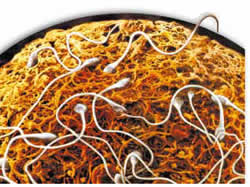 Until fairly recently, it was thought that a baby’s sex was determined by the mother’s cells. Or at least, it was believed that the sex was determined by the male and female cells together. But we are given different information in the Qur’an, where it is stated that masculinity or femininity is created out of “a drop of sperm which has been ejected”.
Until fairly recently, it was thought that a baby’s sex was determined by the mother’s cells. Or at least, it was believed that the sex was determined by the male and female cells together. But we are given different information in the Qur’an, where it is stated that masculinity or femininity is created out of “a drop of sperm which has been ejected”.
“He has created both sexes, male and female from a drop of semen which has been ejected.” (The Qur’an, 53:45-46)
The Qur’an discusses the determination of gender In the Qur’an, it is said that masculinity or femininity are created out of “a drop of semen which has been ejected”. However, until fairly recently, it was believed that a baby’s sex was determined by the mother’s cells. Science only discovered this information given in the Qur’an in the 20th century. This and many other similar details about the creation of man were stated in the Qur’an centuries ago.
The developing disciplines of genetics and molecular biology have scientifically validated the accuracy of this information given by the Qur’an. It is now understood that sex is determined by the sperm cells from the male, and that the female has no role in this process.
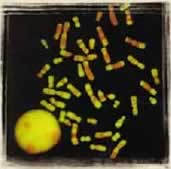
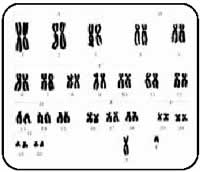
The Y chromosome carries characteristics of masculinity, while the X chromosome carries those of femininity. In the mother’s egg, there is only the X chromosome, which determines female characteristics. In the semen from the father, there are sperms that includes either X or Y chromosomes. Therefore, the sex of the baby depends on whether the sperm fertilising the egg contains an X or Y chromosome. In other words, as stated in the verse, the factor determining the sex of the baby is the semen, which comes from the father. This knowledge, which could not have been known at the time when the Qur’an was revealed, is evidence to the fact that the Qur’an is the word of God.
Chromosomes are the main elements in determining sex. Two of the 46 chromosomes that determine the structure of a human being are identified as the sex chromosomes. These two chromosomes are called “XY” in males, and “XX” in females, because the shapes of the chromosomes resemble these letters. The Y chromosome carries the genes that code for masculinity, while the X chromosome carries the genes that code for femininity.
The formation of a new human being begins with the cross combination of one of these chromosomes, which exist in males and females in pairs. In females, both components of the sex cell, which divides into two during ovulation, carry X chromosomes. The sex cell of a male, on the other hand, produces two different kinds of sperm, one that contains X chromosomes and the other Y chromosomes. If an X chromosome from the female unites with a sperm that contains an X chromosome, then the baby is female. If it unites with the sperm that contains a Y chromosome, the baby is male.
In other words, a baby’s sex is determined by which chromosome from the male unites with the female’s ovum.
None of this was known until the discovery of genetics in the 20th century. Indeed, in many cultures, it was believed that a baby’s sex was determined by the female’s body. That was why women were blamed when they gave birth to girls.
Thirteen centuries before human genes were discovered, however, the Qur’an revealed information that denies this superstition, and referred to the origin of sex lying not with women, but with the semen coming from men.
The Clot Clinging to the Uterus
If we keep on examining the facts announced to us in the Qur’an about the formation of human beings, we again encounter some very important scientific miracles.
When the sperm of the male unites with the ovum of the female, the essence of the baby to be born is formed. This single cell, known as a “zygote” in biology, will instantly start to reproduce by dividing, and eventually become a “piece of flesh” called an embryo. This of course can only be seen by human beings with the aid of a microscope.
The embryo, however, does not spend its developmental period in a void. It clings to the uterus just like roots that are firmly fixed to the earth by their tendrils. Through this bond, the embryo can obtain the substances essential to its development from the mother’s body.(16)
Here, at this point, a very significant miracle of the Qur’an is revealed. While referring to the embryo developing in the mother’s womb, God uses the word “alaq” in the Qur’an:
“Recite: In the name of your Lord Who created man from alaq. Recite: And your Lord is the Most Generous.” (The Qur’an, 96:1-3)
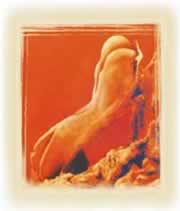 In the first phase of its development, the baby in the mother’s womb is in the form of a zygote, which clings to the uterus in order to take nourishment from the mother’s blood. In the picture to the left is a zygote, which looks like a piece of flesh. This formation, which has been discovered by modern embryology, was miraculously stated in the Qur’an 14 centuries ago with the word “alaq”, which means “a thing that clings to some place” and is used to describe leeches that cling to a body to suck blood.
In the first phase of its development, the baby in the mother’s womb is in the form of a zygote, which clings to the uterus in order to take nourishment from the mother’s blood. In the picture to the left is a zygote, which looks like a piece of flesh. This formation, which has been discovered by modern embryology, was miraculously stated in the Qur’an 14 centuries ago with the word “alaq”, which means “a thing that clings to some place” and is used to describe leeches that cling to a body to suck blood.
The meaning of the word “alaq” in Arabic is “a thing that clings to some place”. The word is literally used to describe leeches that cling to a body to suck blood.
Certainly, the use of such an appropriate word for the embryo developing in the mother’s womb, proves once again that the Qur’an is a revelation from God, the Lord of all the Worlds.
The wrapping of muscles over the bones
Another important aspect of the information given in the verses of the Qur’an is the developmental stages of a human being in the mother’s womb. It is stated in the verses that in the mother’s womb, the bones develop first, and then the muscles form which wrap around them.
“(We) then formed the drop into a clot and formed the clot into a lump and formed the lump into bones and clothed the bones in flesh; and then brought him into being as another creature. Blessed be God, the Best of Creators!” (The Qur’an, 23:14)
Embryology is the branch of science that studies the development of the embryo in the mother’s womb. Until very recently, embryologists assumed that the bones and muscles in an embryo developed at the same time. For this reason, for a long time, some people claimed that these verses conflicted with science. Yet, advanced microscopic research conducted by virtue of new technological developments has revealed that the revelation of the Qur’an is word for word correct.
These observations at the microscopic level showed that the development inside the mother’s womb takes place in just the way it is described in the verses. First, the cartilage tissue of the embryo ossifies. Then muscular cells that are selected from amongst the tissue around the bones come together and wrap around the bones.
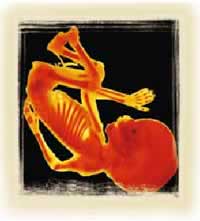 The bones of the baby are clothed with flesh during one particular stage.
The bones of the baby are clothed with flesh during one particular stage.
The bones of the baby completing its development in the mother’s womb are clothed with flesh during one particular stage.
This event is described in a scientific publication titled Developing Human in the following words:
During the seventh week, the skeleton begins to spread throughout the body and the bones take their familiar shapes. At the end of the seventh week and during the eighth week the muscles take their positions around the bone forms.(17)
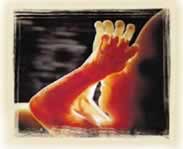
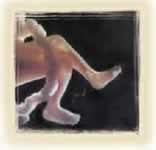
Many stages of a baby’s development in the mother’s womb are related in the Qur’an. As described in verse 14 of Sura Muminun, the cartilage of the embryo in the mother’s womb ossifies first. Then these bones are covered with muscle cells. God describes this development with the verse: “(We then) formed the lump into bones and clothed the bones in flesh”
In short, man’s developmental stages as described in the Qur’an are in perfect harmony with the findings of modern embryology.
Three Stages of the Baby in the Womb
In the Qur’an, it is related that man is created in a three-stage process in the mother’s womb.
“… He creates you stage by stage in your mothers’ wombs in a threefold darkness. That is God, your Lord. Sovereignty is His. There is no god but Him. So what has made you deviate?” (The Qur’an, 39:6)
As will be understood, it is pointed out in this verse that a human being is created in the mother’s womb in three distinct stages. Indeed, modern biology has revealed that the baby’s embryological development takes place in three distinct regions in the mother’s womb. Today, in all the embryology textbooks studied in faculties of medicine, this subject is taken as an element of basic knowledge. For instance in Basic Human Embryology, a fundamental reference text in the field of embryology, this fact is stated as follows: “The life in the uterus has three stages: pre-embryonic; first two and a half weeks, embryonic; until the end of the eight week, and fetal; from the eight week to labor.”(18)
These phases refer to the different developmental stages of a baby. In brief, the main characteristics of these developmental stages are as follows:
1. Pre-embryonic stage
In this first phase, the zygote grows by division, and when it becomes a cell cluster, it buries itself in the wall of the uterus. While they continue growing, the cells organise themselves in three layers.
2. Embryonic Stage
The second phase lasts for five and a half weeks, during which the baby is called an “embryo”. In this stage, the basic organs and systems of the body start to appear from the cell layers.
3. Fetal stage
From this stage on, the embryo is called a “foetus”. This phase begins at the eighth week of gestation and lasts until the moment of birth. The distinctive characteristic of this stage is that the foetus looks just like a human being, with its face, hands and feet. Although it is only 3 cm. long initially, all of its organs have become apparent. This phase lasts for about 30 weeks, and development continues until the week of delivery.
 In the verse 6 of Sura Zumar, it is pointed out that man is created in the mother’s womb in three distinct stages. Indeed, modern embryology has revealed that the baby’s embryological development takes place in three distinct regions in the mother’s womb.
In the verse 6 of Sura Zumar, it is pointed out that man is created in the mother’s womb in three distinct stages. Indeed, modern embryology has revealed that the baby’s embryological development takes place in three distinct regions in the mother’s womb.
Information on the development in the mother’s womb became available only after observations with modern devices. Yet, just like many other scientific facts, these pieces of information are imparted in the verses of the Qur’an in a miraculous way. The fact that such detailed and accurate information was given in the Qur’an at a time when people had scarce information on medical matters is clear evidence that the Qur’an is not the word of man, but the word of God.
Footnotes:
16- Moore, Keith L., E. Marshall Johnson, T. V. N. Persaud, Gerald C. Goeringer, Abdul-Majeed A. Zindani, and Mustafa A. Ahmed, 1992, Human Development as Described in the Qur’an and Sunnah, Makkah, Commission on Scientific Signs of the Qur’an and Sunnah, p. 36
17- Moore, Developing Human, 6. edition,1998.
18- Williams P., Basic Human Embryology, 3. edition, 1984, p. 64.
Source: http://www.zawaj.com/

 Umm Sahl, your sister in Islam, a wife and mother of 3 beautiful blessed babies
Umm Sahl, your sister in Islam, a wife and mother of 3 beautiful blessed babies
SubhanAllah
Assalam Alaikum,
SubhanAllah ,
What better proof required,to say Quran is the word from the Creator!
And to accept the way of life as Submitting one’s Will to Him!
Walaikum Assalam…
Subhan Allah…